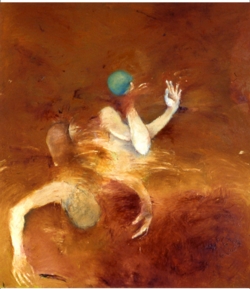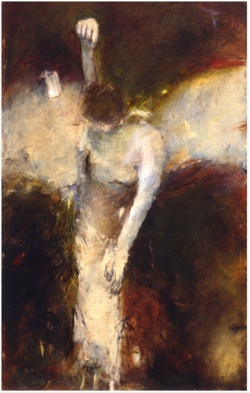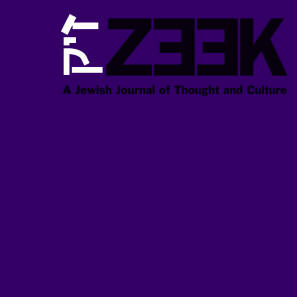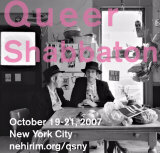 June 07
June 07
The History of "Tikkun Olam"
Jill Jacobs
 There may be no other term that is simultaneously as beloved and as reviled in Jewish progressive circles as the phrase “tikkun olam.” For some people, this concept, generally translated as “repairing the world,” offers the motivation for involvement in social justice work; for others, the term has become so overused and so little understood as to be meaningless.
There may be no other term that is simultaneously as beloved and as reviled in Jewish progressive circles as the phrase “tikkun olam.” For some people, this concept, generally translated as “repairing the world,” offers the motivation for involvement in social justice work; for others, the term has become so overused and so little understood as to be meaningless.
I first encountered the term tikkun olam as a teenager active in United Synagogue Youth, whose community service programs are labeled “Social Action Tikkun Olam” or “SATO” in teen lingo. While I knew that Jews also involved themselves in political action, the “tikkun olam” projects of my youth primarily involved staffing soup kitchens on Christmas day and collecting clothing and cans of food for the poor. In college, I met self-identified secular Jews, for whom Judaism equaled tikkun olam, which equaled radical politics. In rabbinical school, I struggled to understand difficult mystical texts that viewed tikkun as the process of restoring a complex divine unity.
As tikkun olam has increasingly become the “in” Jewish thing, I have heard the term from the mouths of Bill Clinton and Cornel West, and have seen tikkun olam used to describe efforts as diverse as teaching Torah, volunteering for social service agencies, raising money for Israel, and supporting the creation of a Palestinian state. I have come across puzzling references to the “prophetic value of tikkun olam” or “the commandment of tikkun olam.” As a post-biblical term, tikkun olam neither appears in a prophetic book nor constitutes one of the mitzvot. However, as this concept has come to be equated both with a general call to justice, and with specific philanthropic and volunteer activities, the definition of tikkun olam has been merged with those of tzedakah (financial support of the poor), g’milut hasadim (acts of loving kindness), and tzedek (justice).
As the meaning of the term tikkun olam has expanded to apply to virtually any action or belief that the user thinks is beneficial to the world, some Jewish social justice activists and thinkers have moved away from using the term at all. Complaining about the equation of Judaism with liberal politics in an essay titled “Repairing Tikkun Olam” [Judaism 50:4], Arnold Jacob Wolf comments, “All this begins, I believe, with distorting tikkun olam. A teaching about compromise, sharpening, trimming and humanizing rabbinic law, a mystical doctrine about putting God's world back together again, this strange and half-understood notion becomes a huge umbrella under which our petty moral concerns and political panaceas can come in out of the rain.”
Rather than throw out the term tikkun olam altogether, or putting it on a twenty-year hiatus as others have suggested, I propose weaving together the four primary definitions of tikkun olam present in Jewish history: the anticipation of the divine kingdom in the Aleynu prayer; the midrashic call to preserve the physical world; the rabbinic desire to sustain the social order; and the Lurianic belief in our power to restore divine perfection. This definition will occupy a space between a limited definition of “tikkun olam” as relating only to a specific theology or legal process and an expansive definition that equates “tikkun olam” with any type of social action or social justice work.
The History of the Term
The term tikkun olam may have originated as early as the second century CE, and its popularity as a religious concept has waxed and waned in the centuries that have followed. This phrase is fascinating both in its endurance and in its capacity to change meanings according to the needs of the hour. Unlike many other well-known Jewish concepts, such as “shalom,” “Shabbat,” or “tzedek,” the term “tikkuntikkun olam” does not appear in the Bible and appears only in a few discreet instances in the Talmud. Still, this term has, for many, become a de facto pillar of Judaism.
The words “tikkun olam” themselves defy easy translation. The Hebrew verb “t-k-n” is generally translated as “to fix,” but can also mean “to establish.” As we will see, this word takes on more specific connotations in particular contexts. The word “olam,” usually rendered as “world,” also signifies eternity, especially in biblical and other very early texts. Thus, the word “l’olam,” common in biblical, liturgical, and modern Hebrew, means “forever” (for an eternity). Even when referring to the physical world, the term “olam” also carries with it a sense of permanence. To these complications, we can add the question of which particular “world” any given use of the term “tikkun olam” might signify. In some cases, the term refers to the physical world, in others to the societal order, and in still others to the dream of a fully realized divine manifestation. All of these questions make the phrase “tikkun olam” both difficult to understand and also richer in its complexity.
Aleynu: Establishing the Divine Kingdom
The term “tikkun olam” appears first in the Aleynu prayer, which may have been written as early as the second century. Originally part of the Rosh Hashanah liturgy, this prayer now concludes every Jewish prayer service. The move, probably made around the thirteenth century, from the once-a-year appearance of this prayer to its current thrice daily recitation speaks to the resonance of this composition for generations of Jews.
The first section of the Aleynu prayer speaks of the greatness of God and of the particular relationship between God and the Jewish people. The second section introduces the promise that divine sovereignty will eventually encompass the entire world. Within the second part of the prayer, we find the line “l’taken olam b’malchut shaddai” “to establish/fix the world under the kingdom of God.”
To understand the meaning of the term “l’taken olam” here, we need to take a step back and to examine the context in which this line appears. As indicated, the second section of the Aleynu prayer focuses on the promise of God’s ultimate sovereignty. Immediately before introducing the concept of tikkun olam, the text pleads that “idolatry will be swept away, and false gods will be utterly destroyed.” Immediately following the promise of tikkun olam, the text speaks of a time “when all the people of the world will call out God’s name.” The triumph of divine sovereignty requires the elimination of any pockets of resistance to God’s exclusive rule.
To our contemporary pluralist ears, the rejection of other religions appears intolerant and proselytizing. Most contemporary Jews who extol the value of tikkun olam certainly do not understand this term as a mandate to impose worship of the Jewish God on all other peoples.
We may gain some consolation from understanding the Aleynu text as comparatively universalistic within the historical context. The biblical inspiration for this prayer is not the repeated injunction to wipe out idol worshipers and their altars, but rather, the comparatively radical promise, in Isaiah 56:7, that “[God] will bring [the other nations] to my holy mountain and make them joyful in my house of prayer; their burnt offerings and their sacrifices shall be acceptable upon my altar, for my house shall be called a house of prayer for all peoples.”
Such apologetics, however, go only so far. Indeed, the arrogance of the Aleynu prayer is one of the reasons that many communities, including the one in which I most frequently daven, do not recite this prayer out loud at all, and particularly reject the upbeat campy tune often assigned to the end of the prayer; some Reform and Reconstructionist communities have rewritten the text of the prayer. Still, if we put aside the specific issue of idol worship, or assume that most world religions do not practice “idol worship” as conceived by the Bible and early rabbis, we can learn from this prayer a sense that “fixing the world” means working toward the manifestation of divinity in every corner of the world. In our conception, this manifestation of divinity will not require the elimination of other means of religious worship, but rather the establishment of Godly qualities throughout the world.
 In a comment on the line in question, David ben R. Yosef Aboudraham, a thirteenth-century Spanish liturgical scholar explains, “When the impurity is destroyed from the world, then the divine presence will return throughout the world, and the world will be repaired” [Seder Tefillot Rosh Hashanah, Dibbur HaMathil “Al ken”]. We can translate this idea of impurity into a modern context, and say that the achievement of tikkun olam will necessitate an end to all of the “impurities,” such as poverty and discrimination, that block the manifestation of the divine presence.
In a comment on the line in question, David ben R. Yosef Aboudraham, a thirteenth-century Spanish liturgical scholar explains, “When the impurity is destroyed from the world, then the divine presence will return throughout the world, and the world will be repaired” [Seder Tefillot Rosh Hashanah, Dibbur HaMathil “Al ken”]. We can translate this idea of impurity into a modern context, and say that the achievement of tikkun olam will necessitate an end to all of the “impurities,” such as poverty and discrimination, that block the manifestation of the divine presence.
Midrash: Preserving the Physical World
A few midrashim (rabbinic elaborations on the biblical text) suggest a more literal understanding of “tikkun olam” as the physical repair or stabilization of the world. One such usage appears in B’reishit Rabbah, a collection of midrashim on the book of Genesis probably compiled around the fifth century CE. This particular midrash grapples with the question of why God does not proclaim “it was good” at the end of the second day of creation, as God does at the end of all other days of creation. The midrash assumes that this absence indicates that one or more of the phenomena created on the second day was, in fact, not good:
‘And God made the expanse, and it separated the water that was below the expanse from the water that was above the expanse. And it was so. God called the expanse ‘sky.’ And there was evening and there was morning, a second day.’ (Genesis 1:7-8) Why is it that ‘it was good’ is not written in connection with the second day?....Rabbi Chanina said, ‘Because on that day, a schism was created, as it is written, ‘let it divide the waters.’ R. Tavyomi said, ‘If because of a division made l’taken olam and to stabilize it, ‘it was good’ is not written in connection with that day, how much more so should this apply to a schism that leads to the confusion of the world.’ (B’reishit Rabbah 4:7)
What interests us here is not so much the rabbinic explanation of why God does not declare the creation of the heavens to be good, but rather Rabbi Chanina’s literalist use of the term “l’taken olam” “to fix the world.” According to this midrash, the world is “fixed” when it is physically viable, and not when it is spiritually or otherwise perfected as the Aleynu prayer or other texts that we will examine later would have it. Similarly, another midrash, also in B’reishit Rabbah explains that God created rain “l’taken olam and to stabilize it.”(13:16). As in the first text, this midrash uses the term “l’taken olam and to stabilize it” to refer only to the physical preservation of the world.









